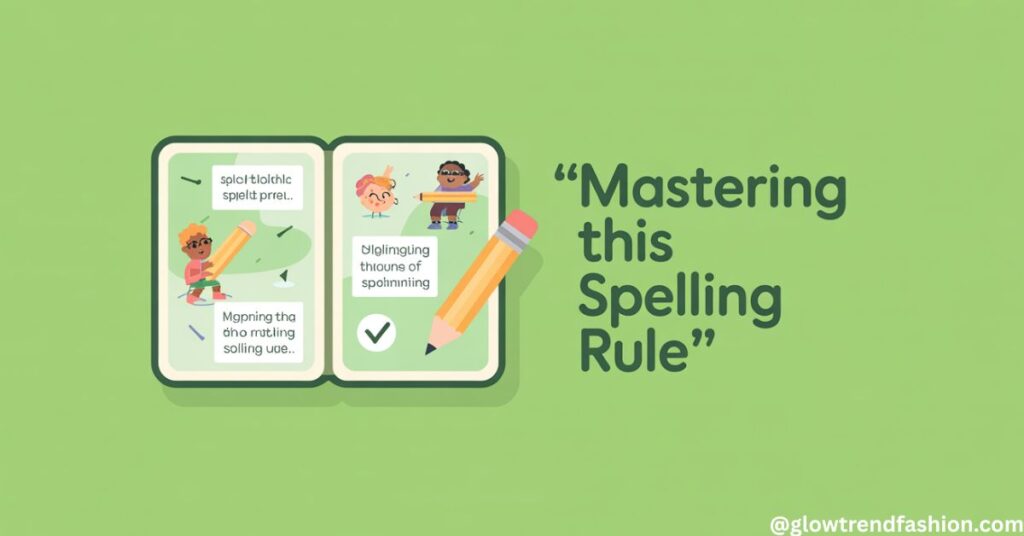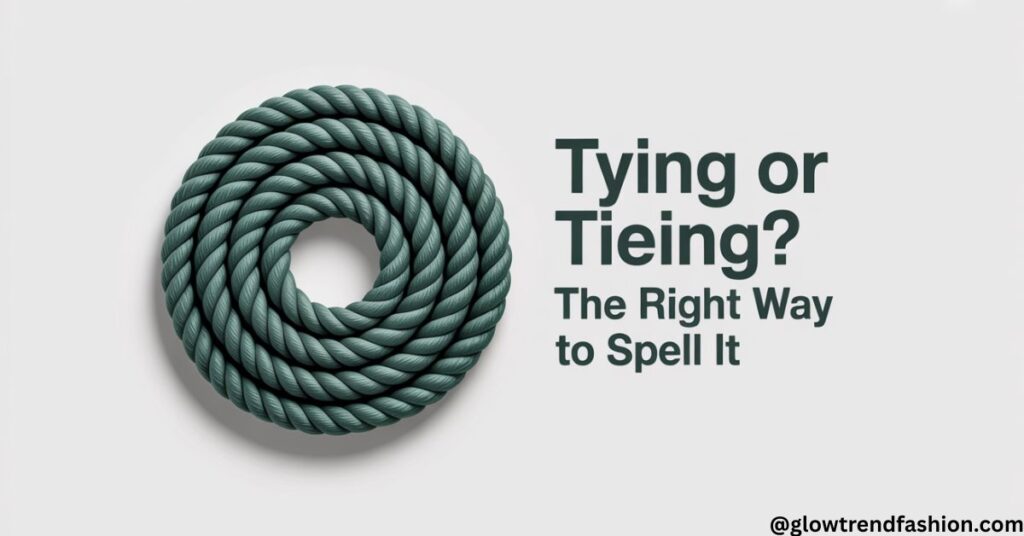Tying or tieing – which spelling should you choose? Picture this: you’re writing an email about securing your camping gear, and you pause mid-sentence. Should you write “I’m tying the rope” or “I’m tieing the rope”? This common spelling dilemma trips up even experienced writers. The answer might surprise you with its simplicity.
Tying stands as the only correct spelling. The word “tieing” doesn’t exist in standard English spelling. Yet millions of people search “is it tying or tieing” every month, proving this confusion runs deep.

Why Does This Confusion Exist?
The confusion stems from how our brains process spelling rules. When we see the base word “tie,” our instincts suggest adding “-ing” directly. After all, most verbs follow this pattern perfectly. “Walk” becomes “walking.” “Talk” becomes “talking.” Simple, right?
But English throws us curveballs. The word “tie” contains that tricky “ie” combination at the end. Your mind might reason: “If I’m adding ‘-ing’ to ‘tie,’ shouldn’t it become ‘tieing’?” This logical thinking actually leads you astray.
Many writers get confused because they overthink the process. They remember hearing about grammar rules for changing letters but can’t recall the specifics. This uncertainty creates doubt about the correct usage.
Consider Sarah, a college student writing her thesis. She typed “tieing” throughout her paper, thinking it looked more “complete” than “tying.” Her spell-checker flagged every instance. She felt embarrassed discovering her mistake, but she’s not alone in this struggle.
“Tying” Stands as the Only Correct Choice

Tying represents the present participle form of the verb “tie.” This verb ending follows a special rule that governs words ending in “ie.” When you encounter a base word ending in “ie,” you must change those letters to “y” before adding “-ing.”
Here’s the transformation:
- Tie → Tying (not tieing)
- Die → Dying (not dieing)
- Lie → Lying (not lieing)
This ie to y rule prevents awkward letter combinations and maintains pronunciation clarity. Without this rule, we’d struggle with unpronounceable spellings.
Think about pronunciation for a moment. “Tying” flows naturally off your tongue. Try saying “tieing” aloud – it sounds forced and unnatural. English spelling evolved to support clear communication, not create obstacles.
Understanding What “Tying” Actually Means
Word tying encompasses several distinct meanings, making it versatile in everyday language. The primary definition involves fastening or securing something with rope, string, or similar materials.
Tying example scenarios include:
- Securing shoelaces before running
- Fastening packages with ribbon
- Binding newspapers for recycling
- Attaching boats to docks
But “tying” extends beyond physical connections. It can mean creating equality in scores or competitions. “The teams are tying 2-2” describes a deadlocked game situation.
The word also describes creating relationships or connections between ideas. “She’s tying historical events to modern politics” shows intellectual linking.
Consider these workplace examples:
- Marketing teams tying product launches to seasonal trends
- Teachers tying lesson plans to state standards
- Doctors tying symptoms to potential diagnoses
Each usage demonstrates the word’s flexibility while maintaining the same correct spelling.
Words That Follow the IE to Y Pattern
The ie to y special rule governs several common English words. Understanding this pattern helps prevent similar spelling mistakes.
| Base Word | Incorrect Form | Correct Form | Meaning |
|---|---|---|---|
| Tie | Tieing | Tying | Fastening/Securing |
| Die | Dieing | Dying | Ceasing to live |
| Lie | Lieing | Lying | Resting horizontally/Being untruthful |
| Pie | Pieing | Pying | Throwing pies (rare usage) |
Notice how each root word ends in “ie.” The transformation to “y” creates smoother pronunciation and follows established grammar rules.
Some writers remember this pattern through the phrase “IE dies, Y flies.” When you see “ie” at a word stem ending, it “dies” and “y” takes flight in its place.
This linguistic rule prevents clunky letter combinations. Imagine pronouncing “dieing” or “lieing” – your tongue would tie itself in knots!
Alternative Ways to Express “Tying”

Understanding synonyms enriches your writing and provides alternatives when word tying feels repetitive. Different contexts call for varied word choices.
Physical fastening synonyms:
- Binding creates stronger security implications
- Securing suggests protective purposes
- Fastening implies temporary attachment
- Knotting specifies the method used
- Lashing indicates tight, firm attachment
Score-related synonyms:
- Equalizing emphasizes balance creation
- Matching suggests exact correspondence
- Deadlocking indicates complete stalemate
- Drawing implies competitive conclusion
Connection-making synonyms:
- Linking suggests logical relationships
- Connecting emphasizes relationship building
- Associating implies mental connections
- Relating shows comparative thinking
Choose synonyms based on your specific meaning. A sailor might prefer “lashing” over “tying” when describing rope work. A sports reporter might choose “equalizing” over “tying” for dramatic effect.
Real-World Usage Examples
Tying example sentences demonstrate proper usage across different contexts:
Everyday situations:
- “Mom spent five minutes tying my little brother’s shoes before school.”
- “The chef was tying fresh herbs into neat bundles for the evening service.”
- “Workers were tying safety ropes around the construction scaffolding.”
Sports contexts:
- “The soccer teams were tying with thirty seconds left on the clock.”
- “Our basketball team keeps tying games in the final quarter this season.”
- “The runners were tying for first place as they approached the finish line.”
Professional settings:
- “The accountant was tying quarterly reports to annual budget projections.”
- “Researchers were tying their findings to previous studies in the field.”
- “The lawyer was tying witness testimonies to establish a clear timeline.”
Each example shows correct usage while maintaining natural sentence flow. Notice how “tieing” would look completely wrong in every instance.
The Etymology Behind “Tying”
The base word “tie” traces back to Old English “tigan,” meaning “to bind” or “to fasten.” This word origin explains why the modern spelling follows specific patterns.
Middle English evolved the word to “tien,” which eventually became our modern “tie.” The present participle formation followed established verb rules for words ending in “ie.”
Historical grammar rules developed to maintain pronunciation consistency. Medieval scribes noticed that adding “-ing” directly to “tie” created pronunciation problems. The ie to y transformation solved this issue elegantly.
Old manuscripts show various spelling attempts before standardization. Some scribes wrote “tyinge,” others “tiynge.” The modern “tying” emerged as the most phonetically logical choice.
Understanding this etymology helps explain why “tieing” never gained acceptance. It represents a spelling that historical language development rejected for practical reasons.
Common Mistakes and How to Avoid Them
Even professional writers occasionally stumble with tying or tieing decisions. These strategies prevent embarrassing errors:
Memory techniques:
- Remember “IE dies, Y flies” for all ie-ending words
- Visualize the word without the ‘e’ before adding ‘-ing’
- Practice writing the correct spelling multiple times
Proofreading strategies:
- Use spell-checkers, but don’t rely on them completely
- Read sentences aloud to catch pronunciation issues
- Ask colleagues to review important documents
Common error patterns:
- Rushing through emails creates spelling shortcuts
- Informal writing contexts reduce attention to grammar rules
- Mobile typing often bypasses spell-checking features
Professional copywriters suggest keeping a personal list of frequently confused words. Add “tying” to your list with a note about the ie to y rule.
Mastering This Spelling Rule

The correct spelling of “tying” follows logical English spelling patterns once you understand the underlying special rule. Remember that base word endings in “ie” always transform to “y” when adding “-ing.”
This grammar rule isn’t arbitrary it serves pronunciation and readability purposes. Proper usage becomes automatic with practice and awareness.
Frequently Asked Question
Is it spelled tying or tieing?
Tying is the correct spelling.
The word “tieing” doesn’t exist in standard English. When you add “-ing” to the base word “tie,” you follow the ie to y rule – the “ie” changes to “y” before adding the suffix.
So it’s always:
- Tie → Tying (not tieing)
This follows the same pattern as other words like “die → dying” and “lie → lying.” The correct spelling is “tying” whether you’re talking about fastening something, creating a knot, or matching a score in sports.
Is it tieing the knot or tying the knot?
Tying the knot is the correct phrase.
The expression uses “tying” – the proper spelling of the present participle form of “tie.” Whether you’re talking about the literal act of making a knot or the figurative meaning of getting married, it’s always spelled tying.
Examples:
- “They’re tying the knot next spring” (getting married)
- “I’m tying the knot tighter to secure the rope” (literal knot-making)
Remember, “tieing” isn’t a real word in English. The correct spelling follows the ie to y rule, so “tie” becomes “tying” when you add “-ing.”
Is it tying back or tieing back?
Tying back is the correct phrase.
The proper spelling is “tying” – never “tieing.” This applies to all uses of the word, including the phrase “tying back.”
Examples:
- “She’s tying back her hair for the workout”
- “The gardener is tying back the rose bushes”
- “I’m tying back the curtains to let in more light”
Remember, “tieing” doesn’t exist in standard English. The correct spelling always follows the ie to y rule, where “tie” becomes “tying” when adding “-ing.” This spelling rule applies consistently whether you’re tying knots, tying scores, or tying back anything.
Is tieing or tying in the Oxford Dictionary?
Only tying appears in the Oxford Dictionary.
There is no entry in the Oxford English dictionary for tieing in American or British English. The Oxford Dictionary recognizes “tying” as the standard, correct spelling for the present participle of “tie.”
Major dictionaries consistently include:
- Tying – listed as the proper present participle form
- Tieing – not recognized as a legitimate dictionary entry
The Oxford English Dictionary, Cambridge Dictionary, and Merriam-Webster all feature “tying” as the official spelling. They don’t include “tieing” as an accepted alternative in modern English.
Is it tying or tieing for first place?
Tying for first place is the correct phrase.
The proper spelling is “tying” – never “tieing.” This applies whether you’re talking about sports competitions, academic rankings, or any situation where multiple people or teams share the same position.
Examples:
- “The two runners are tying for first place in the marathon”
- “Both students are tying for first place in the spelling bee”
- “The teams finished tying for first place with identical scores”
Remember, “tieing” isn’t a real word in English. The correct spelling follows the ie to y rule consistently. Whether you’re physically tying something or describing equal competition results, it’s always spelled “tying.”
What is Tieing?
Tieing is an incorrect spelling of the word “tying.”
Tying means fastening or joining something with a string, rope, or similar material, often by making a knot.
Example: She is tying her shoelaces.
So, “tieing” should be corrected to “tying.”
Conclusion
Mastering the tying or tieing distinction strengthens your overall writing skills significantly. Remember that correct spelling matters in professional communication, academic writing, and everyday correspondence. The ie to y special rule applies consistently across English spelling patterns, making “tying” the only acceptable choice.
Whether you are tying knots, tying scores, or tying concepts together, this spelling rule never changes. Practice using tying example sentences in your daily writing to build muscle memory. Strong grammar rules knowledge separates confident writers from hesitant ones. Your correct usage of “tying” demonstrates attention to detail and language mastery that readers notice and respect.

Isa Bella is an experienced fashion blogger at Glow Trend Fashion, passionate about style, trends, and personal expression. With years of expertise in the fashion industry, she shares insightful tips, fashion guides, and the latest style updates.







